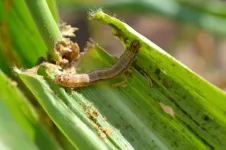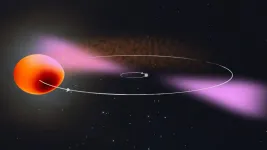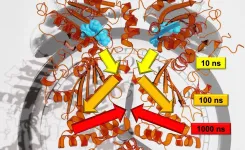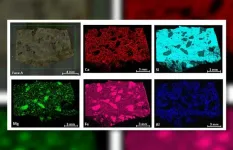(Press-News.org) CABI scientists have updated the first major study of potential biological controls that could be used in the fight against the devastating fall armyworm in Africa. The research offers new insight into evidence of their efficacy in the field and increased availability as commercial products.
Indeed, the review, published in the Journal of Applied Entomology, includes many biocontrol products which are now featured in the CABI BioProtection Portal - a free web-based tool that enables users to discover information about registered biocontrol and biopesticide products around the world.
The fall armyworm (Spodoptera frugiperda) attacks around 100 species of plant but favours maize. It has already caused substantial damage to staple crops grown by smallholder farmers in many parts of Africa.
Lead researcher Dr Melanie Bateman, together with other CABI colleagues and scientists from the International Centre of Insect Physiology and Ecology (ICIPE) in Nairobi, Kenya, and Lancaster University, UK, reveal the revised list of biopesticide active ingredients (AI) - which have been registered in one or more of the 30 study countries for fall armyworm management - now stands at 41.
The current paper builds on the first assessment (Bateman et al, 2018) by profiling four additional AI. These are Aspergillus oryzae, Autographa californica multiple nucleopolyhedrovirus (AcMNPV), Spodoptera littoralis nucleopolyhedrovirus
(SpliNPV) and thyme oil.
Dr Bateman said, "Many smallholder farmers continue to resort to pesticides to tackle the fall armyworm but we believe that safe, sustainable and effective interventions such as biopesticides should be a key element of Integrated Pest Management plans.
"This is particularly important when you consider that many farmers are using highly hazardous pesticides without personal protective equipment and the use of broad-spectrum pesticides can negatively impact natural enemies to help manage fall armyworm."
The scientists add that since the first assessment field trials demonstrating the efficacy have been carried out for eight AIs (A. oryzae, azadirachtin, B. thuringiensis subsp. aizawai, maltodextrin, FAW sex pheromones, spinosad, Spodoptera frugiperda multiple nucleopolyhedrovirus and Spodoptera littoralis nucleopolyhedrovirus) which has led to products being registered across some countries in Africa.
Dr Steve Edgington, co-author of the paper and who is responsible for product data on the CABI BioProtection Portal, said, "The findings of this update are encouraging. In the relatively short time since the last assessment, the number of biopesticide AIs registered per country that could potentially be used to manage FAW has more than doubled, and there have been similar increases in the numbers of products registered. But of course, at the farm gate knowledge is still needed of what products are actually available and how to use them correctly."
"I would recommend farmers and extension workers to keep up to date with the latest biopesticide products available in their region to fight the fall armyworm, and a range of other pests for that matter, by using tools such as the CABI BioProtection Portal."
The researchers added that further studies could include, for many AIs, looking at establishing the most cost-effective method of use to fight the fall armyworm.
INFORMATION:
Additional information
Photo: Fall armyworm on maize (Credit: CABI).
Full paper reference
Bateman ML, Day RK, Rwomushana I, et al. Updated assessment of potential biopesticide options for managing fall armyworm (Spodoptera frugiperda) in Africa.
J Appl Entomol. 2021;00:1-10.
https://doi.org/10.1111/jen.12856
Funding acknowledgement
CABI is an international intergovernmental organization, and we gratefully acknowledge the core financial support from our Member Countries (and lead agencies) including the United Kingdom (Foreign, Commonwealth & Development Office-FCDO), China (Chinese Ministry of Agriculture and Rural Affairs), Australia
(Australian Centre for International Agricultural Research), Canada(Agriculture and Agri-Food Canada), Netherlands (Directorate-General for International Cooperation-DGIS) and Switzerland (Swiss Agency for Development and Cooperation). See https://www.cabi.org/about-cabi/who-we-work-with/key-donors/ for details.
This work was carried out as part of the Action on Invasives programme,
which is funded by DGIS and FCDO. This paper is an update to a previous study funded by the Global Project 'Green Innovation Centres for the Agriculture and Food Sector' implemented by the Deutsche Gesellschaft für Internationale Zusammerarbeit (GAS), commissioned by the Federal Ministry of Economic Cooperation and Development (BMZ). This review is the work of the authors and
does not necessarily reflect the views of DGIS, FCDO or GIN. CABI and the authors would like to thank partners in national governments in Africa for their support and contributions, Stuart Bateman (Bozeman, Montana, USA) for support with the pesticide analysis and Roma Gwynn (Biorationale) for advice.
The behavior of the solvated electron e-aq has fundamental implications for electrochemistry, photochemistry, high-energy chemistry, as well as for biology--its nonequilibrium precursor is responsible for radiation damage to DNA--and it has understandably been the topic of experimental and theoretical investigation for more than 50 years.
Though the hydrated electron appears to be simple--it is the smallest possible anion as well as the simplest reducing agent in chemistry--capturing its physics is...hard. They are short lived and generated in small quantities and so impossible to concentrate and isolate. Their structure is therefore impossible to capture with direct experimental observation such as diffraction methods or NMR. Theoretical modelling has turned out to ...
An international research team including members from The University of Manchester has shown that a rapidly rotating neutron star is at the core of a celestial object now known as PSR J2039?5617
The international collaboration used novel data analysis methods and the enormous computing power of the citizen science project Einstein@Home to track down the neutron star's faint gamma-ray pulsations in data from NASA's Fermi Space Telescope. Their results show that the pulsar is in orbit with a stellar companion about a sixth of the mass of our Sun. The pulsar is slowly but surely evaporating this star. The team also found that the companion's orbit varies slightly and unpredictably over time. Using their search ...
Consider for a moment a tree swaying in the wind. How long does it take for the movement of a twig to reach the trunk of the tree? How is this motion actually transmitted through the tree? Researchers at the University of Freiburg are transferring this kind of question to the analysis of proteins - which are the molecular machinery of cells. A team of researchers lead by Prof. Dr. Thorsten Hugel of the Institute of Physical Chemistry, and Dr. Steffen Wolf and Prof. Dr. Gerhard Stock of the Institute of Physics are investigating how the signals that cause structural changes in proteins travel from one site to another. They are also trying to ...
Washington, DC / New Delhi, India - Researchers at CDDEP have released, The State of the World's Antibiotics in 2021, which presents extensive data on global antimicrobial use and resistance as well as drivers and correlates of antimicrobial resistance, based on CDDEP's extensive research and data collection through ResistanceMap, a global repository that has been widely used by researchers, policymakers, and the media.
Since the first State of the World's Antibiotics report in 2015, antimicrobial resistance has leveled off in some high-income countries but continues to rise in many low- and middle-income countries (LMICs), where access to antibiotics has risen with increases in gross ...
Researchers have found new evidence that global warming is affecting the size of commercial fish species, documenting for the first time that juvenile fish are getting bigger, as well as confirming that adult fish are getting smaller as sea temperatures rise. The findings are published in the British Ecological Society's Journal of Applied Ecology.
The researchers from the University of Aberdeen looked at four of the most important commercial fish species in the North Sea and the West of Scotland: cod, haddock, whiting and saithe. They found that juvenile fish in the North Sea and on the West of Scotland have been getting bigger while adult fish have been getting smaller. These changes ...
The world's largest bird, the ostrich, has problems reproducing when the temperature deviates by 5 degrees or more from the ideal temperature of 20 °C. The research, from Lund University in Sweden, is published in Nature Communications.
The results show that the females lay up to 40 percent fewer eggs if the temperature has fluctuated in the days before laying eggs. Both male and female production of gametes is also negatively affected.
"Many believe that ostriches can reproduce anywhere, but they are actually very sensitive to changes in temperature. Climate change means that temperatures will fluctuate even more, and that could be a challenge for the ostrich", says Mads Schou, researcher at Lund ...
Mothers are at increased risk of mental health problems as they struggle to balance the demands of childcare and remote working in COVID-19 lockdowns, according to new research from an international team of researchers.
The findings, published in the journal Psychological Medicine, were drawn from a comprehensive, online survey of mothers in China, Italy and the Netherlands.
Changes to their working lives, family strife and loss of social networks emerged as common factors affecting the mental health of mothers in all three countries.
The study was carried out by a team from Radboud University, ...
Scientists from MIPT, Moscow Pedagogical State University and the University of Manchester have created a highly sensitive terahertz detector based on the effect of quantum-mechanical tunneling in graphene. The sensitivity of the device is already superior to commercially available analogs based on semiconductors and superconductors, which opens up prospects for applications of the graphene detector in wireless communications, security systems, radio astronomy, and medical diagnostics. The research results are published in a high-rank journal Nature Communications.
Information transfer in wireless networks is based on transformation of a high-frequency continuous electromagnetic wave into a discrete sequence of bits. This technique is known as signal modulation. ...
People receiving treatment for cancer are known to feel better with physical training. But does it make any difference how vigorously they exercise? A new study by researchers at Uppsala University shows that whether the training is intensive or rather less strenuous, its effect is roughly the same. The results are published in the journal Scandinavian Journal of Medicine and Science in Sports.
Physical activity and training during cancer therapy improve physical and mental health, and may also reduce the most common side effects of the treatment. This has been confirmed in several international studies. Many patients suffer from cancer-related fatigue, and both resistance and endurance training are known to lessen fatigue. ...
The IBeA research group from the University of the Basque Country's Department of Analytical Chemistry, Faculty of Science and Technology, is participating in NASA's Mars2020 space mission, which is scheduled to touch down on Mars in February this year. Specifically, the group has participated in constructing and verifying the chemical homogeneity of the templates included on the calibration card of the SuperCam instrument mounted on the Perseverance. 'We made a set of pads perfectly characterised in accordance the instruments we have here, in order to enable us to verify that the LIBS and Raman spectroscopy measurements taken by the SuperCam are correct,' explains Doctor Cristina García-Florentino. 'Raman spectroscopy is a technique ...





